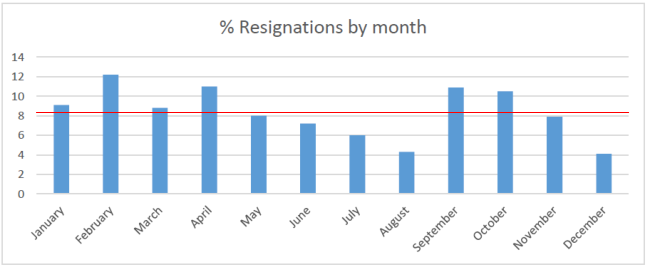Blue monday resignations
 Published: 2018-01-02
Published: 2018-01-02
It is normally at this time of the year that many news outlets run stories seemingly off the back of some dodgy pseudo-science formula described in a press release. Beit from travel agencies, drinks companies or job search websites, we are told that “Blue Monday” or the third Monday in January is when we are the most depressed and downbeat - thus we should book an expensive holiday, go out drinking with friends or dust off the CV and find a new job.
Intrigued or sceptical about these claims, I decided to look at the historical data in Manta to see if there was any type of seasonal trend in resignations and specifically if there was any type of peak around the infamous Blue Monday.
Manta does not store resignation dates as such, but we do know dates that employees left a company and using an assumption that most people have to give a month’s notice, then we can have a rough approximation of when they might have resigned.
Using the last two years of data from Manta, across all companies, the percentage of people leaving per month (minus one month notice period) gives the following graph:

The red line shows the 8.33% mean that we would expect if it was an even distribution.
It is clear, from our data, that January is not by far the most common month to resign, in fact, there is a relatively a low standard deviation (2.7) across our sample.
There is a peak in February and again in September/October. Maybe people decide on Blue Monday that enough is enough and they want to get a new job, but it takes another month or so to actually find the dream position and therefore resign in February? Likewise in the autumn - maybe after the summer, sitting on a beach or by the pool, we reflect on our career and decide that we need to move on.
In conclusion, it does not seem that there is much of a Blue Monday effect in terms of resignations, within our dataset at least.